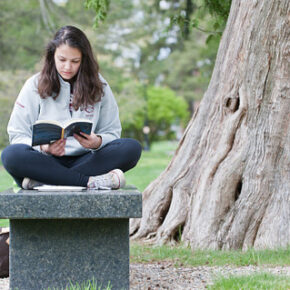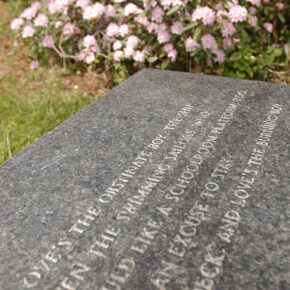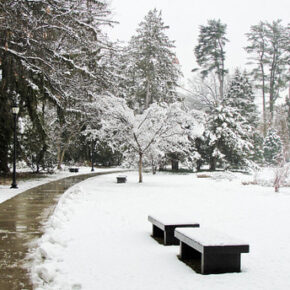Today’s post comes from Tara Peterson, Vassar class of 2025 and Art Center student docent.
On the path leading from Main Building to the Gordon Commons are a series of dark, granite benches engraved with what at first appear as ominous diary entries and cryptic messages. This is the poetry of alumna Elizabeth Bishop ‘34, and the benches, titled For Elizabeth, are the work of artist Jenny Holzer (b. American, 1950–present).
Holzer, who specializes in using quotational references and writing in her practice, was commissioned in 2006 to complete a work in honor of the retirement of the then president of Vassar, Francis Fergusson. In researching the college, Holzer came across Bishop’s writing and decided to utilize it as a part of her project. The series, which consists of twenty Laurentian Green granite benches honoring the twenty years of President Fergusson’s tenure at Vassar, features segments from some of the author’s most famous poems including “The Waiting Room.” The installation is one of her last works that feature pieces written by others, as the artist has moved towards using her own writing in her art.




Bishop was considered a landmark modernist poet, receiving numerous recognitions throughout her life including a Pulitzer Prize and National Book Award. Holzer’s use of Bishop’s poetry in the installation was meant to reflect “the different types of journeys, inward or outward, that students make during their years on campus,” which was enunciated in alumna’s poem, “The Shampoo.”
Bishop’s use of identity in her poetry reflects Holzer’s intentions.. As an author, Bishop publicly subverted the new biographical writing style that many writers were adopting. Privately, her work was very personal and reflected her history of neglect and abuse, as well as her identity as a lesbian woman. Bishop’s writing balances ominosity and melancholy and the omission of information imparts an air of mystery.
Much like Holzer’s idea of the journey students take throughout their years at Vassar, Bishop underwent a significant transformation in her journey as a poet. Her earlier work focused heavily on her unhappy childhood, stemming from an overwhelming uncertainty caused by being shuffled between relatives. By using segments of Bishop’s poems that refer to this uncertainty, as well as the ‘islands’ that the poet imagined for herself as a safe haven, the artist purveys the ambiguity students might feel throughout their time on campus. After her move to Brazil in 1951, Bishop’s writing became greatly about the unknown and untravelled.The openness and personal nature of Bishop’s poetry not only draws in many students making their way on the path, like myself, but also expresses relatable feelings of uncertainty and wonder.
Coincidentally, the Loeb’s new Assistant Director of Learning and Community Engagement, Amanda Potter, worked in Holzer’s studio as a graduate student at the time of the benches’ creation. Amanda explained her role in the project: “With Holzer’s work, especially when she is employing another person’s writing, it’s essential that every last comma, dash, and apostrophe be exactly as they are in the original.” Amanda’s job consisted primarily of making sure Bishop’s poetry was properly transcribed and then to ensure the stencils used to engrave the benches were correctly placed. That second task she completed was visiting the stone carving studio in Vermont where the benches were fabricated. Amanda’s visit to Vassar earlier this year during her hiring process was actually the first time she saw the benches in their completion.
Although the history behind the poetry on the Holzer benches is unknown to many students, that doesn’t stop the series from being an undeniable landmark on campus, just as Bishop herself is to the history of the College. Today Vassar’s Special Collections Library holds the largest collection of Bishop’s work and personal letters, which Megan Marshall used to write her 2017 biography on Bishop, Elizabeth Bishop: A Miracle for Breakfast. Bishop’s legacy in her writing remains as enlightening and heart clenching as ever, and it’s no wonder that Holzer would be drawn to use Bishop’s writing in her installation, a decision which would ultimately take Bishop’s pre-existing imprint, and manifest it into physical reality.




